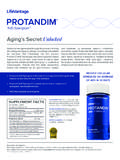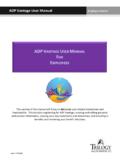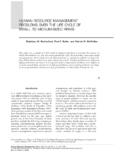Transcription of Material Safety Data Sheet
1 Material Safety data Sheet 1 of 5 I - PRODUCT IDENTIFICATION Product: Trichlor 1 Tablets; Trichlor 3 Tablets Chemical Family: Chloroisocyanurate Formula: C3Cl3N3O3 CAS Number: 87-90-1 Synonyms: 1,3,5-trichloro-s-triazine-2,4,6-trione; TCCA; Trichlor; Symclosene; trichloroisocyanuric acid. COMPANY IDENTIFICATION 24 HR EMERGENCY TELEPHONE NUMBER AllChem Performance Products, LP INFOTRAC (Transportation): (800)535-5053 6010 NW First Place Gainesville, FL 32607 Tel:352-378-9696 II COMPOSITION, INFORMATION ON INGREDIENTS Exposure Limits Chemical or Common Name: OSHA PEL: ACGIH TLV.
2 Trichloroisocyanuric acid 96-100% Not established Not established Dichloroisocyanuric Acid 0-4% (This product may or may not contain a proprietary pigment less ) III - HEALTH HAZARD data Primary Route(s) of Entry: Ingestion: (X) Inhalation: (X) Skin Contact: () Eye Contact: () Carcinogenicity Listings: OSHA: () NTP: () IARC: () Primary Health Hazards: Acute: Corrosive to eyes, skin and mucous membranes.
3 Harmful by inhalation and if swallowed. Chronic: Prolonged exposure may cause damage to the respiratory system. Chronic inhalation exposure may cause impairment of lung function and permanent lung damage. Signs & Symptoms of Exposure: Ingestion: Irritation and/or burns can occur to the entire gastrointestinal tract, including the stomach and intestines, characterized by nausea, vomiting, diarrhea, abdominal pain, bleeding and/or tissue ulceration. Ingestion causes severe damage to the gastrointestinal tract with the potential to cause perforation. Inhalation: Irritating to the nose, mouth, throat and lungs. It may also cause burns to the respiratory tract with the production of lung edema that can result in shortness of breath, wheezing, choking, chest pain, and impairment of lung function.
4 Inhalation of high concentrations can result in permanent lung damage from the corrosive action of the lung. Skin Contact: Dermal exposure can cause severe irritation and /or burns characterized by redness, swelling and scab formation. Repeated skin exposure may cause tissue destruction due to the corrosive nature of the product. Eye Contact: Severe irritation and/or burns can occur following eye exposure. Contact may cause impairment of vision and corneal damage. This product is corrosive to all tissues contacted and upon inhalation, may cause irritation to mucous membranes and respiratory tract. There are no known or reported effects from repeated exposure.
5 Toxicological investigation indicated it does not produce significant effects from chronic exposure Material Safety data Sheet 2 of 5 Medical Conditions Aggravated By Exposure: Asthma, respiratory and cardiovascular disease. IV- FIRST AID MEASURES Emergency and First Aid Procedures: Ingestion: If swallowed, wash mouth thoroughly with plenty of water and give water to drink. Get medical attention immediately. Note: Never give an unconscious person anything to drink. Inhalation: In case of dust inhalation or breathing fumes released from heated Material , remove person to fresh air. Keep person quiet and warm. Apply artificial respiration if necessary and get medical attention immediately.
6 Skin Contact: Remove contaminated clothing. Wash skin thoroughly with mild soap and plenty of water for at least 15 minutes. Wash clothing before re-use. Get medical attention immediately. Eye Contact: Holding the eyelids apart, flush eyes promptly with copious flowing water for at least 20 minutes. Get medical attention immediately. NOTE TO PHYSICIAN: Corrosive. In case of ingestion do not induce vomiting. No specific antidote. Treat symptomatically and supportively. V FIRE FIGHTING MEASURES FIRE AND EXPLOSION HAZARD data Flash Point: Not applicable Auto-Ignition Temperature: Not applicable Flammable Limits: Not applicable. LEL: UEL: Extinguishing Media: Water.
7 Do not use dry chemical extinguisher containing ammonia compounds. Special Fire-fighting Procedures: Fire fighters should wear full protective clothing and self-contained breathing apparatus (SCBA) in positive pressure mode. Cool containers with water spray. On small fires, use water spray or fog. On large fires, use heavy deluge or fog streams. Flooding amounts of water may be required before extinguishment can be accomplished. Unusual Fire and Explosion Hazards: When heated to decomposition, may release poisonous and corrosive fumes of nitrogen trichloride, chlorine, nitrous oxides, cyanates, carbon monoxide and carbon dioxide. VI ACCIDENTAL RELEASE MEASURES Steps To Be Taken In Case Material Is Spilled Or Released: Personal Precautions: For small spills in a well-ventilated area, wear a NIOSH approved half-face or full face tight fitting respirator or a loose fitting powered air-purifying respirator equipped with chlorine cartridges.
8 After Spillage/Leakage: Hazardous concentrations in air may be found in local spill area and immediately downwind. If spill Material is still dry, do not put water on this product as a gas evolution may occur. On Soil: Do not contaminate spill Material with any organic materials, ammonia, ammonium salts or urea. On water: This Material is heavier than and soluble in water. Stop flow of Material into water as soon as possible. Begin monitoring for available chlorine and pH immediately. In air: Vapors may be suppressed by the use of water fog. VII HANDLING AND STORAGE Precautions to Be Taken in Handling and Storage: Handling: Avoid bodily contact. Do not take internally. Upon contact with skin and eyes, wash off with water.
9 Storage: Store in a dry, cool, well-ventilated area away from incompatible materials. Product has an indefinite shelf-life limitation. Do not store at temperatures above 60 C/140 F. Available chlorine loss can be as little as per year at ambient temperatures. Other Precautions: This information in this Material Safety data Sheet should be provided to all who will use, handle, store, transport, or otherwise be exposed to this product. This information has been prepared for the Material Safety data Sheet 3 of 5 guidance of plant engineering, operations and management, and for persons working with or handling this product. Type of product and use: For formulation into end-use products intended for disinfectants, sanitizers, fungicides, bactericides and algaecides for pools, spas, hot tubs, industrial recirculating water cooling towers, air washers and evaporative condensers, sewage treatments, food contact surfaces, laundry and egg sanitizing.
10 VIII EXPOSURE CONTROLS/PERSONAL PROTECTION Respiratory Protection: When dusty conditions are encountered, wear a NIOSH/OSHA full-respirator with chlorine cartridges for protection against chlorine gas and dust/mist pre-filter. A respiratory protection program meeting OSHA and ANSI requirements must be followed whenever workplace conditions warrant a respirator's use. Ventilation: Local Exhaust: Use local exhaust ventilation to minimize dust and chlorine levels where industrial use occurs. Otherwise, ensure good general ventilation. Mechanical Exhaust: Other Protective Clothing or Equipment: Use Neoprene gloves, Use chemical Safety glasses to avoid eye contact. Where industrial use occurs, chemical goggles may be required.






